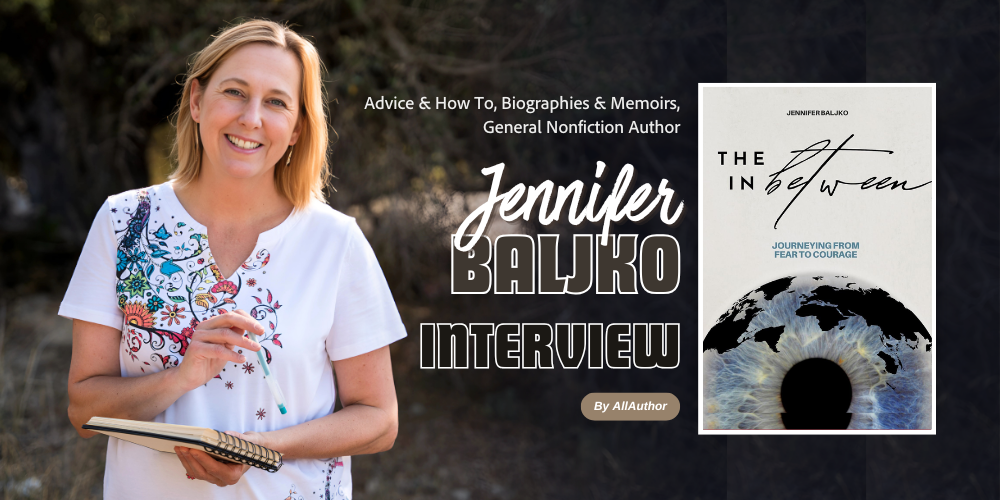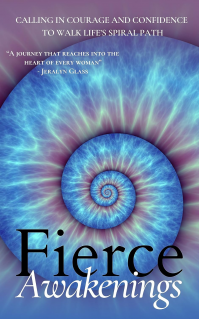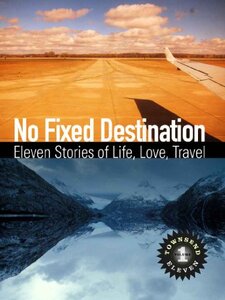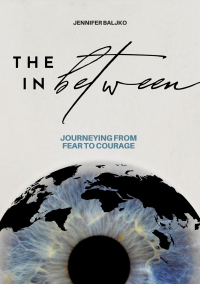Jennifer Baljko Interview Published on: 05, Feb 2025
 Can you tell us about your journey as a writer and what inspired you to focus on helping midlife women navigate the space between fear and courage?
Can you tell us about your journey as a writer and what inspired you to focus on helping midlife women navigate the space between fear and courage?
I started writing as a kid, making up and acting out stories with my siblings and friends. With the hope of giving voice to people who felt they did not have a voice, I pursued a journalism career, and was a reporter, editor, and freelance writer for nearly 30 years at newspapers, magazines, and various business publications. In my 30s, I fell in love with the intimate way personal essays unfolded a story and captured a moment in time. That love deepened and seeded the idea of writing nonfiction books and anthologies.
In my late 40s, after completing my 16,000-kilometer Bangkok Barcelona On Foot walk and in lockdown with the Covid pandemic, I rediscovered how simple acts of making art, in all its forms, filled me with joy, gratitude, and motivation. In what I now call Creativity Intervals, I would move my body for a few minutes, meditate for a few minutes, and, for a few minutes more, would let my hands doodle, paint, draw, color, sketch or wander across the page with no goal in mind.
As I made these intervals a regular part of my daily routine, I realized how many women my age seemed to have lost their playfulness. Busy all the time with life, work, family, care-taking responsibilities, and starting the sometimes unsettling journey through menopause, many of my friends and colleagues had no time for spontaneous fun.
These are the tear lines of my generation. We embodied so fully the work-hard-live-hard, do-it-all, Wonder Woman dynamic that we forgot how to ease off and create for the sake of creating, just for the fun of it.
Taking a few minutes to kindle, nurture, and play in creative spaces, to be silly and have drops of fun sprinkled throughout my day, has been game-changing for me, and I love showing others what it could mean to them, too. I work with midlife women and crones (the older, wiser women among us) because I want to help them find their smiles again and witness for themselves the genius embedded in their creative glimmers. There is a giddy delight in witnessing how a few minutes of doodling, mindful writing, and intuitive, unguided movement wakes up a woman who has not experienced that kind of joy, pleasure, and playfulness for many years.
Creativity and making time to wonder with a curious heart become valuable tools for navigating the ebbs and flows of life, especially when we midlifers have achieved most of our 30-year life goals and the “What next?” question feels more rhetorical than actionable.
As we move through our 40s, 50s, 60s, we –women of a certain age :-) – have a reckoning with who we once were, who we are now, and who we still want to become. We wake up and realize that we climbed many of our ambitious mountains. We did the hard things. We failed, and we succeeded. We lived. We lost. We rose again and shined brighter. At some point, life demands a creative pivot towards what feels deeply aligned to our core values, not society’s expectations. That recognition, and the uncertainty that comes with it, can spark anxiety, worry, and, yes, even fear.
Having explored my creative edges, I have become more attuned to seeing how I responded to fear over the course of my life and how I believed courage was the only way to kill fear. By writing _The In Between_, I understand now that there are many other emotional responses between fear and courage.
Many women, many people, hold themselves back creatively and otherwise because of a fear they have carried for decades and are just beginning to know how to name. If I can help shake off some of that fear, help women step into their heart of courage, and, from that powerful and tender place, create with wild abandon, then I’ve lived my mission.
What personal experiences shaped your decision to guide others in rediscovering their creative superpowers?There are many, but the one I hold dear comes from my long walk.
To keep myself entertained while walking two continents, I found myself in deep problem-solving monologues. I dubbed these self-talks “In the world according to Jenn.” In these silent speeches, I imagined tackling the world’s biggest problems and presenting invented solutions to world’s leaders. The imaginary presentations usually started with something like “If I was running the world, I would try this.”
What I noticed is that many of the “In the world according to Jenn” solutions I thought up involved bringing together a great number of people from around the world, from all walks of life, to sit down, talk and draft new sustainable live-life-well blueprints we could all aspire towards.
During one of these stretches, I wondered, “What if we all knew we had a creative superpower? How would we use it? Would we hide it away? Would we turn up the brightness of inner light if we knew we had this gift?” Those questions and inner dialogs influenced the way I created Always On My Way as a collaborative hub to discover the creative superpowers we’re each born with but may not fully understand.
How does your role as a mindfulness meditation teacher and Emotional Tour facilitator influence your writing and mentoring process?Writing and mentoring are emotional journeys both for me and for my mentees. So many things come up when someone sits down and commits to sharing their story. It can be overwhelming, scary, or nerve-wracking to confront the hard edges of life in story form. Over time, if not expressed, many of these emotions get stuck in our bodies or loop around our minds as ungrounded and unchecked negative thoughts. That negative self-talk hurts our creativity and damages our inspiration.
I help ease this pressure, both with individual clients/mentees or in small group settings, with invitations to intuitively move with and through feelings of anger, grief, joy, and confidence, among other emotions. Once the body knows it has space and a safe ways to experience these emotions, then the mindfulness meditation techniques I learned and share create a sense of stability that encourages writers to sit down and write.
Even as I facilitate these practices, I allow myself to be a student as well. There’s always more to learn when it comes to emotional intelligence and resilience and the mindset that’s needed to turn dreams into reality.
"Fierce Awakenings" brought together 11 women to share their stories. What was the most rewarding and challenging part of leading this collaborative project?The _Fierce Awakenings_ collaborative book was one of my most rewarding professional experiences. It was my proving ground for stepping into the role of mentor, leader, and space-holder, roles that I had shied away from at other times in my life.
The three biggest challenges were:
1. Turning strangers into a community of sisters who still even now, long after publication, love and care for each other. Over the course of the nine-month writing, editing, publishing, and marketing cycle, I always held close the idea of nurturing the bonds between each of these women. For me, they were always at the center of everything, and the book was a pleasant and predictable outcome I knew would come because of the commitment we made to each other.
2. Managing multi-dimensional emotional roller coasters in multiple time zones. Writing personal stories brings up a lot of things at different times for different people. We were spread across three countries, and the writing breakdowns happened at various moments. I had to constantly learn when I needed to step in with tenderness, turn on my listening ears, refrain from offering advice, or come in with a firmer approach and say, “Come you. You got this. Don’t give up.”
3. Allowing everyone to be sovereign with their choices while creating a safe container where everyone had their say and felt heard. Even though I was the lead author, developmental editor, and scheduling task master holding everyone to our publisher’s deadline, I tried not to dictate the rules or enforce “This is the way we do things.” I wanted this to be collaborative co-creation, and that meant being flexible as the project evolved.
I hope they walk away with these key realizations:
You are not only fearful or fearless. There are other options and states of being between these end points.
Many emotional stepping stones guide you through your fear response and the courageous action you choose to take…you have to look a little bit closer to see them.
Once you recognize your own patterns, you will be able to more effectively dissect your fear, feel the range of emotions that ebb and flow through your decision-making process, and then make a heart-centered choice with integrity, grace, and confidence.
My walk from Thailand to Catalonia was, and still is, one of my greatest teachers. Every moment during the walk, and particularly when we walked through big cities with millions of people, required extreme amounts of physical, mental, and emotional attention and a refined, intuitive ability to determine in milliseconds if something or someone was a danger or if it was a harmless encounter.
Without fully understanding how it happened, I became very good at reading nonverbal cues, gestures, and facial expressions. I honed an ability to sense what was happening in my immediate environment and respond appropriately. The ability to tune into that level of awareness and discernment in my environment created a visceral way to take notes with my body, which overlaps with the mental picture I hold as a memory. This body-mind-emotional connection has improved my storytelling because I’m not only relying on notes in my journal, an Instagram post, or the visual clip my mind holds. I’m also saying to my body, “What do you remember about that experience?” and that creates a multi-dimensional perspective.
The documentary about your journey has gained international attention. How does it feel to see your personal story impact others through this medium?I’m very proud of the documentary, its message about the kindness that exists in the world, and the impact it continues to have on people. I’m overjoyed with the way our producer, director, and friend Quim Badenes, founder of Barcelona-based Klimax Films, put the story together and the vision he held for it while finishing the production during the pandemic.
When we set out for the walk, we had no intention of making a film about it and barely shot any video. My partner Lluís and I had thousands of photos, but only a handful of 10-second video clips. When Quim found out about our walk in January 2019, six months before we finished our 3.5-year adventure, he had to scramble to get footage, and he came out to film us as we inched closer to Barcelona. It was amazing to watch him be inspired by our experiences and use his felt-sense of inspiration to thread together the storyline that makes our 27-minute documentary so impactful.
The documentary’s core theme is about the kindness of strangers and how so many ordinary people in the 21-nation-states we walked through stepped forward to help us. It’s a message as old as time, but in the world we live in today where “us vs them” tendencies cause suspicion and a fear of others, our documentary reminds people of a truth they know and want to believe in again. I’m glad we can give them this glimmer of hope.
What advice would you give to someone struggling to write because of fear or self-doubt?Self-doubt is not a good enough reason to give up on your story. In fact, if you’re feeling doubtful, write more! ?
Doubt is a normal, recurring, human mental state. It usually comes up when you’re reaching the edge of your comfort zone. If you let self-doubt run rampant and unchecked, you’ll shrink your greatness and lose your shine. If you consistently practice acknowledging and naming the doubts you’re feeling and develop an ability to park your doubts while you write, you’ll strengthen your emotional resilience and eventually determination, enthusiasm, and confidence will fuel your writing process.
You’ve worked as a journalist, editor, and mentor for nearly 30 years. How have these roles enriched your approach to storytelling and coaching?Each career pivot has taught me different ways to tell stories. I moved from writing concise newspaper articles answering the who, what, when, why and how questions to learning how to convey complex emotions and human behavior in personal essays to holding space tenderly for people who are just beginning to muster up enough courage to share what they experienced.
One of the common threads binding my work, life, and coaching together is that I always knew I am meant to help give voice to people who feel like they don't have a voice or are just beginning to learn how to use their voices. As a former journalist and now as a developmental editor, I ask questions I know readers want answered. As a writing mentor, I ask my mentees to speak honestly about what they want from their books, what impact they envision their story will have on the world, and to identify the one ideal reader they want to bond with through their story. The big learning that has come from this is to be both willing to ask the questions that need to be asked AND to listen to the answer with judgment or expectations.
Can you share some memorable moments from your workshops or women’s circles that highlight the power of creative expression?One just happened in January 2025 when I offered a Sacred Crafting workshop. In this session, I wove together a meditative story with journaling prompts, effigy-making, ritual burning, and creating a becoming board. Watching the participants acknowledge, celebrate, and be proud of their accomplishments over the last 5 years and willingly choose to let go of the qualities that no longer serve them made my heart smile.
We’re so future-facing in our day-to-day pursuits, we forget that we are ALWAYS inventing ways to accomplish hard things and deal with whatever life throws at us. Part of the power of creative expression is simply remembering that we are creative beings trying to create something meaningful with our lives.
What practices or tools do you recommend for aspiring authors to connect with their inner voice?I always recommend developing a mindfulness practice that feels good to you. It doesn’t matter if you have a formal daily 20-minute meditation practice or allow just enough time every day to notice 10 rounds of inhales and exhales or watch the clouds roll by for three minutes. Any mindfulness practice, regardless of the length of time, helps bring you back into the present moment and return to a feeling of groundedness. Groundedness, in turn, ushers in feelings of calmness and stability. And that calm center provides a space where you can actually hear yourself think and receive messages from your inner voice or higher self.
Your work integrates mindfulness and embodiment techniques. How do these approaches help writers overcome blocks and tap into their creativity?I believe in living life as a full-sensory experience, and that means practicing ways to align my mind, body, and heart with my higher, soul-directed purpose. Listening and reacting to only my thoughts never gets me far enough in expressing the fullness of my life. My body knows so many things and speaks a different language than my mind; it’s constantly telling me things I want (and don’t want) to know. Same with my emotional body, run by my emotional center, my heart...there’s so much to learn from my emotional triggers and responses I probably need three lifetimes to study myself.
For me, choosing to have a full-sensory experience of my life gives me plenty of material to write about. I can’t imagine ever running out of content!
This might just be the secret to creativity no one talks about or doesn’t realize. You are not just your thoughts or feelings or great ideas or physical state.
What role do you see community and collaboration playing in the creative process for midlife women?Community and collaboration are heart-opening delights, and they are foundational to Always On My Way’s vision of bringing midlife women and crones together in creative play spaces.
Midlife women have already proven themselves. They’ve had their families, their careers, their joys, and their sorrows. Maybe they took on some of these things all on their own. Maybe they had support along the way from friends, family, spouses, or colleagues. However they climbed their mountains, they did it.
As we get older (and wiser), we realize community and collaboration help all of us rise higher because we have a stronger sense of belonging and connection. We want to throw down the rope and help other women climb the mountains; the view from the top is sweeter when we’re all there! Our need to compete and win–qualities we had to engage with to get ahead in the world, especially the corporate world–shifts and the better question becomes “How can we go further together?” Community and collaboration help open those creative portals.
What future projects or initiatives are you excited about? Are there new topics or themes you plan to explore?Curiously, after an intense multi-year period of following my creative and productivity bliss, which led to the making and hosting of three multi-day online global conferences, publishing two books, and touring with the documentary, I found myself in late 2024 craving a slower time of inner winter. So I followed that call, and allowed myself time to fallow my fields, to rest more, and to not attach myself to a specific 2025 goal.
That said, three things I’m looking forward to are:
- Traveling for an extended amount of time. I’ve missed being out in the world seeing how life unfolds in places culturally different than my own.
- Exploring a new book idea…it’s still very formless, but the preliminary concept has to do with goodbyes and releasing our heartache.
- Continuing to bring the documentary and _The In Between_’s conversations around kindness, fear, and courage to online workshops, masterclasses, podcasts, and in-person events.
I’m so grateful to be part of the AllAuthor community. It’s nice to be in a virtual place where books, stories, and authors matter. I love browsing the site and seeing what people are writing about and how the book covers capture the essence of the stories. AllAuthor’s services, namely the book cover contests and the weekly promotional graphics, provide easy ways to do book marketing, which is not my favorite part of the writing and publishing process. Having AllAuthor resources at my fingertips saves me time and energy. I pull down the AllAuthor book graphic from my email, pop it into my newsletter or post it on social media, and get on with my day.
Thank you very much for this opportunity to share pieces of my story here, for the support and encouragement you give all authors everywhere, and for being a community beacon for writers. May we all move upwards and may our stories lift the world higher.
Jennifer "Jenn" Baljko is a mindful writing mentor, speaker, author, and the founder of Always On My Way, dedicated to helping midlife women navigate the space between fear and courage to embrace life with confidence. Living near Barcelona, Jenn celebrates her unique journey as a 50-something crone who giggles often, dances in circles, and lets joy be her guide. Through her work, she inspires others to embrace their own path of empowerment and fulfillment.
 Fierce Awakenings: Calling in Courage and Confidence to Walk Life's Spiral Path
Genre: Religion & Spirituality
Fierce Awakenings: Calling in Courage and Confidence to Walk Life's Spiral Path
Genre: Religion & Spirituality
 No Fixed Destination: Eleven Stories of Life, Love, Travel (Townsend 11 Vol 1)
Genre: Biographies & Memoirs
No Fixed Destination: Eleven Stories of Life, Love, Travel (Townsend 11 Vol 1)
Genre: Biographies & Memoirs
 No Set Boundaries: Eleven Stories of Life, Travel, Misadventure (Townsend 11, Vol 2)
Genre: Biographies & Memoirs
No Set Boundaries: Eleven Stories of Life, Travel, Misadventure (Townsend 11, Vol 2)
Genre: Biographies & Memoirs
 No Definite Plans: Eleven Stories of Laughter, Love, Travel (Townsend 11, Vol 3)
Genre: Biographies & Memoirs
No Definite Plans: Eleven Stories of Laughter, Love, Travel (Townsend 11, Vol 3)
Genre: Biographies & Memoirs


